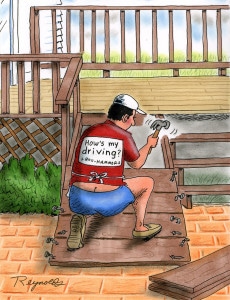OVERVIEW
 Deck Articles
Deck Articles
Building Sturdy Decks
Wood Decking
Composite Decking
Deck Stains & Finishes
Fasteners & Connectors
Framing Materials
Deck Railings
With careful attention to materials and structural details, it’s possible to build decks will last for decades and require minimal maintenance. However, decks are tough applications for building materials. The structural framework is exposed to the weather and often contacts the ground. Decking surfaces are exposed to sun, rain, and snow, as well as heavy foot traffic.
To add to the challenge, today’s treated wood is highly corrosive to Metal Fasteners. Modern building codes have responded with important safeguards for Building Safe and Durable Decks. Structural connections and proper flashing are especially important for long-term performance.
Despite the beating these materials take, more than ever we want decks to be low or no maintenance. This has spawned a vast array of Composite and Plastic Decking materials vying for our interest, with marketers sometimes promising more than they can deliver in the areas of performance and low maintenance.
Not surprisingly, consumers’ high expectations combined with the real-world performance of many relatively untested formulas has lead to more than a few consumer complaints. Several class-action suits have been launched against composite and plastic decking companies – mostly for premature failure from decay, cracking, or surface deterioration. In many cases, the problems were linked to quality control issues and only affected a specific batch of materials.
The good news is that manufacturers have had well over 20 years now to tweak their recipes and have learned to curb their marketing enthusiasm, emphasizing maintenance needs, product care, and realistic expectations of performance and appearance. Despite some notable exceptions, composites and plastics have proven themselves as durable alternatives to wood decking. In fact, non-wood decking now accounts for almost 50% of the decking market.
For those who want real Wood Decking, but without the annual ritual of cleaning and sealing, Tropical Hardwoods offer a excellent alternative. Prices have come down, making these products competitive with high-end composites and plastics.
The leading choice in high-end hardwoods is Ipe, but several other species such as cumaru and garapa offer similar performance at lower prices. Ipe and similar species provide natural resistance to decay and insects like old-growth redwood, but with a density and hardness that can provide decades of service with minimal maintenance.
Porches are basically decks, with partial walls and roofs – at least that’s how they a usually built today. To simplify construction and reduce costs, many porches use the same methods and materials as exterior decks with a roof overhead. Since porch floors get less exposure to rain and sun, they are less prone to crack and warp and can, therefore, be built with less durable materials than open decks. For example, painted tongue-and-groove ¾-in. flooring is common on older porch floors. Today standard exterior decking with drainage gaps is more common in porches as it is more forgiving and requires less maintenance.
Leave a Reply